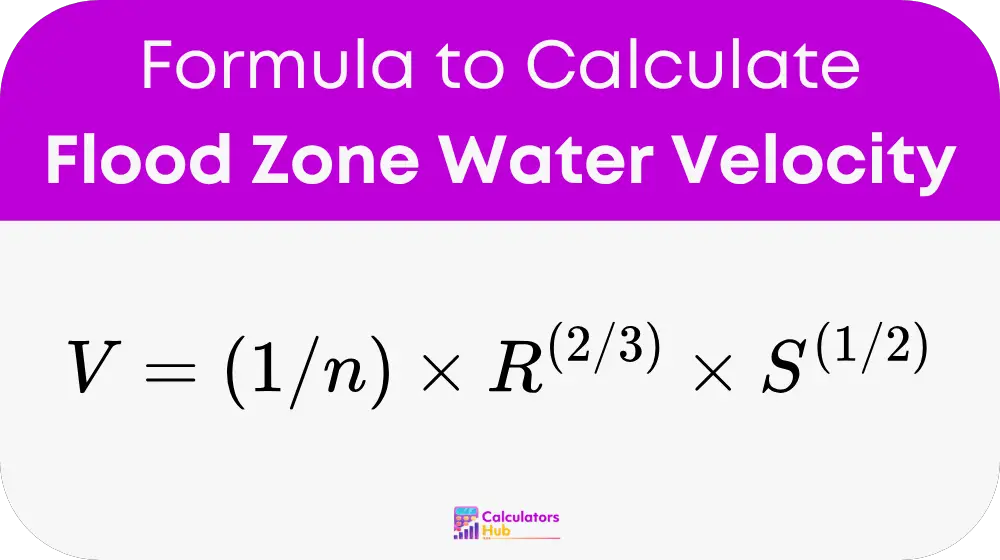The Flood Zone Water Velocity Calculator estimates the speed at which water moves through a flood-affected area or open channel. It uses the widely accepted Manning’s equation, which helps engineers and planners evaluate how fast floodwaters will travel over land or through channels like rivers, creeks, or storm drains.
Under
standing flood water velocity is crucial for floodplain mapping, hydraulic modeling, disaster response planning, and designing safe infrastructure. High velocities can lead to erosion, structural damage, and increased danger to people and property. This calculator simplifies the process of determining velocity by allowing you to input common field measurements like slope, channel area, and surface roughness.This tool falls under the hydraulic engineering and flood risk analysis calculator category and supports critical planning in civil, environmental, and municipal engineering.
s="wp-block-heading">formula of Flood Zone Water Velocity Calculator

Where:
V = Water velocity (in meters per second or feet per second)
n = Manning’s roughness coefficient (dimensionless; based on channel surface type)
R = Hydraulic radius = A / P
A = Cross-sectional flow area (in m² or ft²)
P = Wetted perimeter (in meters or feet)
S = Slope of the energy grade line (typically the channel bed slope)
Each variable plays a key role:
-
s="wp-block-list">
- n depends on the material (concrete, gravel, vegetation)
- R considers the shape of the channel
- S reflects the steepness of the channel bed
This equation is accurate for uniform open-channel flow, commonly used in flood simulations and waterway design.
s="wp-block-heading">Helpful Reference Table: Typical Values and Velocity Ranges
This table includes standard Manning's n values and example slope and hydraulic radius conditions to show how velocity changes across different surfaces and gradients.
| Surface Type | n Value | Slope (S) | R (Hydraulic Radius) | Estimated Velocity (ft/s) |
|---|---|---|---|---|
| Concrete channel | 0.015 | 0.002 | 2.0 ft | ~7.9 ft/s |
| Earth, no vegetation | 0.022 | 0.003 | 1.5 ft | ~5.3 ft/s |
| Grass-lined swale | 0.035 | 0.01 | 0.75 ft | ~3.4 ft/s |
| Gravel bed stream | 0.030 | 0.005 | 1.2 ft | ~4.6 ft/s |
| Natural stream (rocky) | 0.045 | 0.008 | 1.0 ft | ~3.1 ft/s |
Use this table as a quick reference when assessing general flood channel behavior or estimating safe flow speeds for infrastructure and site evaluation.
Example of Flood Zone Water Velocity Calculator
Suppose you're analyzing a grass-lined drainage channel with the following parameters:
-
s="wp-block-list">
- Manning’s n = 0.035
- Slope (S) = 0.01
- Cross-sectional area (A) = 1.5 m²
- Wetted perimeter (P) = 2.0 m
Step 1: Calculate the hydraulic radius (R)
R = A / P = 1.5 / 2.0 = 0.75 m
Step 2: Apply the formula
V = (1 / 0.035) × (0.75)^(2/3) × (0.01)^(1/2)
V ≈ 28.57 × 0.826 × 0.1 ≈ 2.36 m/s
So, t
he water in the flood zone would be moving at approximately 2.36 meters per second. This is considered moderate flow and could still pose erosion risks or threaten structural integrity if not managed properly.Most Common FAQs
Flood water velocity shows how fast the water moves. Faster water increases the force against buildings, roads, and bridges. It also carries debris and increases erosion, making it vital for safety and design.
The n value depends on the surface of the floodplain or channel. Smooth concrete has a lower value, while natural or vegetated surfaces have higher values. FEMA and engineering handbooks provide standard tables for reference.
Yes, it helps in designing drainage systems, assessing flood risks in cities, and modeling stormwater flows. Knowing velocity helps engineers size culverts, channels, and flood protections effectively.